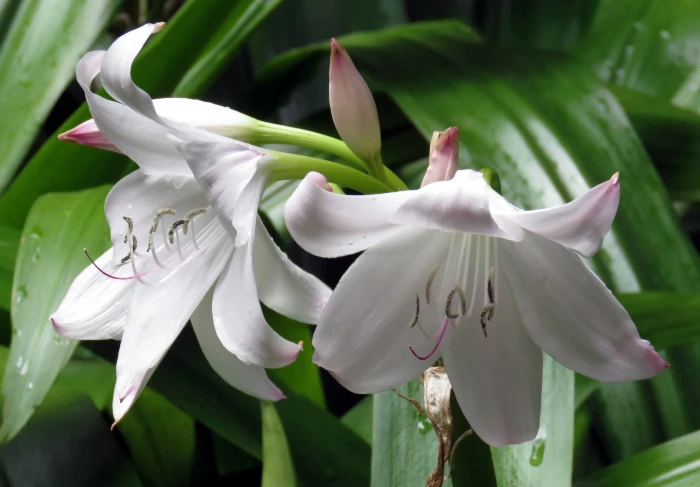Natal Lily
(Crinum moorei)
Natal Lily (Crinum moorei)
/
/

Prosthetic Head
CC BY-SA 4.0
Image By:
Prosthetic Head
Recorded By:
Copyright:
CC BY-SA 4.0
Copyright Notice:
Photo by: Prosthetic Head | License Type: CC BY-SA 4.0 | License URL: https://creativecommons.org/licenses/by-sa/4.0 | Uploader: Prosthetic Head | Publisher: Wikimedia Commons | Title: WhiteFlowers_SA.JPG | Notes: User created page with UploadWizard |
























Estimated Native Range
Climate Requirements for Bielefeld, Germany
| This Plant | Your Site | Plant Suitability for Your Location | ||
|---|---|---|---|---|
| • Precipitation | 17" - 103" | 33" | Your precipitation may be insufficient for this plant. Irrigate N" / year. | Irrigate N" / year |
| • High Temp. | 58°F - 93°F | 73°F | Your summer temperatures are normal for this plant. | Excellent |
| • Low Temp. | 3°F - 73°F | 31°F | Your winter temperatures are normal for this plant | Excellent |
This plant should grow well at your location with about N inches per year (Y minutes per month) of irrigation.
Summary
Crinum moorei, commonly known as Natal Lily, is a semi-deciduous perennial bulb originating from the grasslands and marshy areas of Eastern South Africa, particularly in KwaZulu-Natal. It typically grows to a height of 1-3 feet (0.3-0.9 meters) and a width of 2-4 feet (0.6-1.2 meters). The Natal Lily is recognized for its large, strap-shaped leaves and showy, fragrant flowers that bloom in summer and fall. The flowers are trumpet-shaped, predominantly pink with a white throat, and are borne on tall stalks that rise above the foliage, creating an eye-catching display.
Natal Lily is valued for its striking flowers and ability to add a tropical feel to gardens. It is often used in borders, water garden settings, and as a focal point in mixed plantings. This plant prefers full sun to partial shade and requires medium amounts of water, thriving in well-drained soils rich in organic matter. While generally easy to maintain, it is sensitive to frost and should be protected in cooler climates. Overwatering can lead to bulb rot, so proper soil drainage is crucial. The Natal Lily is not known for aggressive roots or significant disease problems, making it a reliable choice for many gardeners.CC BY-SA 4.0
Natal Lily is valued for its striking flowers and ability to add a tropical feel to gardens. It is often used in borders, water garden settings, and as a focal point in mixed plantings. This plant prefers full sun to partial shade and requires medium amounts of water, thriving in well-drained soils rich in organic matter. While generally easy to maintain, it is sensitive to frost and should be protected in cooler climates. Overwatering can lead to bulb rot, so proper soil drainage is crucial. The Natal Lily is not known for aggressive roots or significant disease problems, making it a reliable choice for many gardeners.CC BY-SA 4.0
Plant Description
- Plant Type: Bulb
- Height: 1-3 feet
- Width: 2-4 feet
- Growth Rate: Moderate
- Flower Color: Pink, White
- Flowering Season: Summer, Fall
- Leaf Retention: Semi-Deciduous
Growth Requirements
- Sun: Full Sun
- Water: Medium
- Drainage: Medium
Common Uses
Bee Garden, Butterfly Garden, Low Maintenance, Salt Tolerant, Showy Flowers
Natural Habitat
Grasslands and marshy areas of Eastern South Africa
Other Names
Common Names: Moore’s Crinum, Ngomi Lily, Inanda Lily, Fönsterkrinum
Scientific Names: Crinum moorei, Amaryllis moorei, Crinum colensoi, Crinum imbricatum, Crinum mackenii, Crinum makoyanum, Crinum makoyanum var. roseum, Crinum moorei var. variegatum, Crinum natalense
GBIF Accepted Name: Crinum moorei Hook.f.